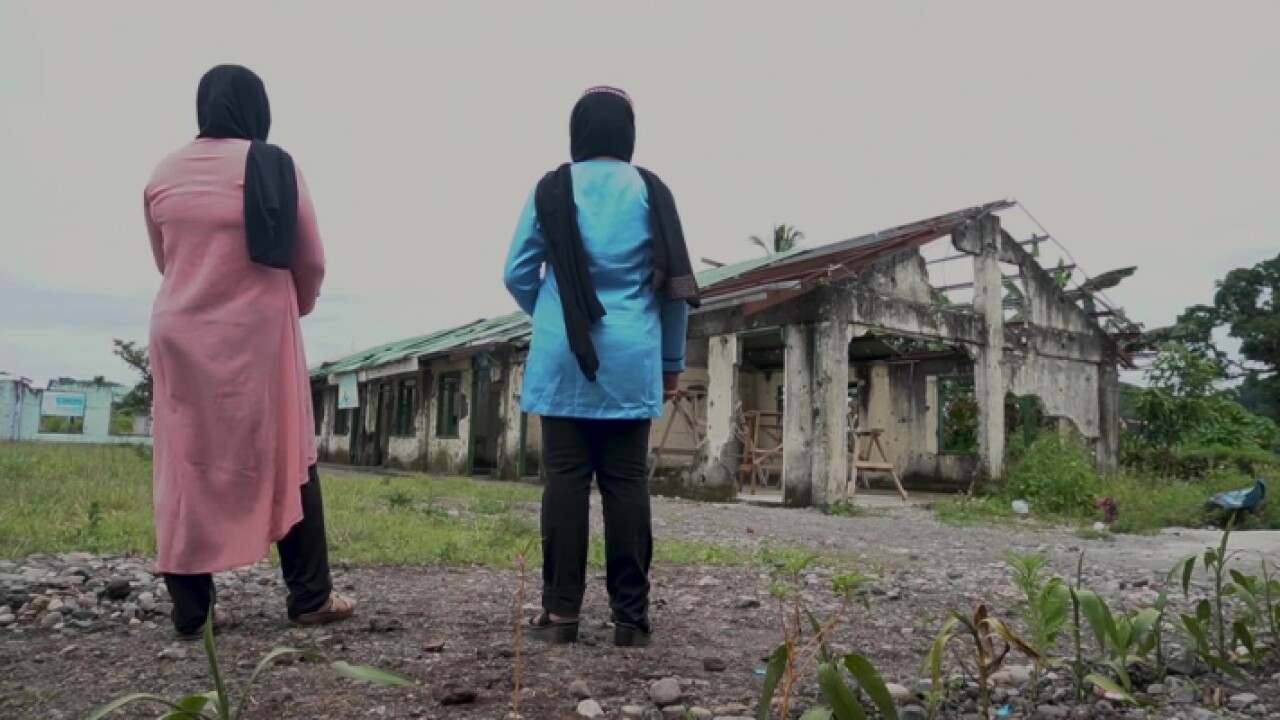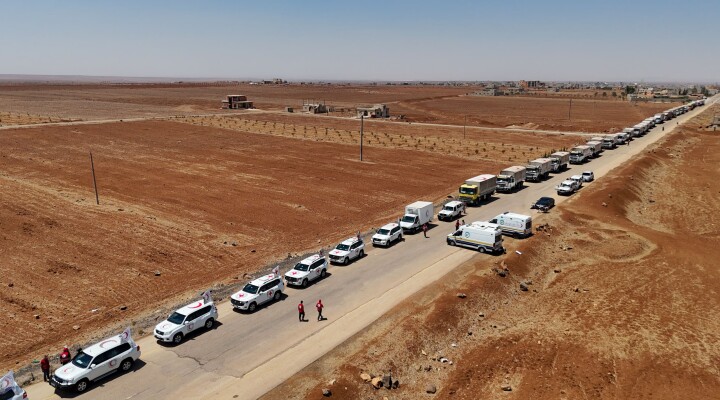Video news footage: conflict and COVID-19 pandemic doubly impact education in Butig, Philippines

This is a modal window.
In Mindanao, the Philippines’ island in the south, protracted conflicts and constant displacement has seriously disrupted young people’s access to education. The long-term repercussions of this for children and the community at large are barely reported.
Ragayan Elementary School in Butig town, Lanao del Sur province, was severely damaged in the conflict between government security forces and a non-state armed group in 2016, along with houses and farms in the two most severely affected villages (barangays) of Ragayan and Poctan.
Some 390 families (approximately 1,950 people) fled to Marawi but were displaced again after a larger armed conflict devastated this city in 2017. The conflict’s impact on the remote municipality was somehow forgotten after the hostilities shifted to the Marawi.
Since 2017, over 250 pupils and their teachers endured an unsafe space in Ragayan—when the rains poured, the pupils got wet because of the bullet-riddled structure, while the teacher’s chalk on the blackboards dissolved. With only two functional classrooms from a previous six, the school had to group students in shifts, with kindergartners and 1st to 3rd graders in the mornings, and 4th to 6th graders in the afternoons.
The International Committee of the Red Cross (ICRC), which has access to this town through the humanitarian aid it provided during the 2016 hostilities, sought in 2019 the support of the community and the ministry of education of the Bangsamoro Autonomous Region in Muslim Mindanao (BARMM) to help the pupils of Ragayan to have a conducive space to study.
Plans to build a temporary learning space and to build a new school structure were pegged for 2020, but the COVID-19 pandemic caused delays. After the easing of some restrictions, 90 members of the community finally managed to work together to build and complete the wooden temporary learning space by the end of September through ICRC’s cash-for-work project.
With this project, the students now have a conducive space where they can study while the old and bullet-riddled buildings will be demolished and rebuilt into permanent classrooms complying with the standards of the Department of Education.
Today, due to restrictions for face-to-face learning, Ragayan’s pupils are unable to use the new space and are staying home to study through modules and two-way radio, with the support of their dedicated teachers and parents. But they now have something to look forward to as the ICRC plans to build the new, more permanent structure next year.
For further information, please contact:
Amer Hassan Sanggacala (in Iligan), mobile: +63 917 321 5787
Allison Lopez (in Manila), mobile: +63 908 868 6884
Follow ICRC Philippines on facebook.com/ICRCph/
LOGLIST
Location: Ragayan village, Butig town, Lanao del Sur province, Mindanao island, Philippines
Date of filming: 7-8 October 2020
Length: 07:07
On-screen credit: ICRC
Copyright: ICRC
00:01 to 00:04 - Wooden sign of Welcome to Barangay (village) Ragayan
00:05 to 00:08- BRoll of daily life in Ragayan: boys walking on the neighborhood
00:09 to 00:14- BRoll of daily life in Ragayan: woman washing her clothes in a river
00:15 to 00:20- BRoll of daily life in Ragayan: farmers tending to their field
00:21 to 00:25- BRoll of daily life in Ragayan: close-up of a mosque with prayers as audio background
00:26 to 00:29- BRoll of daily life in Ragayan: view of a wooden house and green fields
00:30 to 00:39- House riddled with holes as a result of 2016 armed conflict
00:40 to 00:44- Ragayan Elementary School, also severely damaged as a result of the fighting
00:45 to 00:49- View of student in a classroom from a hole in the school’s wall
00:50 to 00:55- Visible damage to school walls
00:56 to 01:00- Teachers looking at damaged school
01:01- 01:15- Namraida Bao, Ragayan Elementary School principal
Noong nakita ko ito, na sira-sira ang school ko, nakaiyak na ako kasi yun… memorable ng papa ko at saka yung mga bata namin interest(ed) sila (na mag-aral).
When I saw the damage to the school, I cried. The school brings with it memories of my father, and the kids there are interested (to study).
01:16- 01:20- View of hole in the classroom’s roof
01:21- 01:25- Pupil (young boy) sitting alone in the classroom
01:26- 01:30- Hole on blackboard
01:31- 01:56- Namraida Bao, Ragayan Elementary School principal
Nahihirapan kami kasi noon... (pauses, teary eyed) yung bata namin na hindi sila... (pauses again, trying to stop tears). Kasi nahihirapan kami yung bata namin na, kapag nagsusulat, tinu(tu)luan ng ulan at saka yung teacher namin (kapag) nagsusulat sa blackboard na nae-erase kasi yung ulan.
We had a difficult time before… Our pupils had a difficult time (because of the damage). When the rain poured, their notebooks got soaked and the teacher’s writings on the blackboard get erased.
01:57- 02:10- Teacher and principal inspecting books that were damaged after being soaked in rain
02:11- 02:24- Namraida Bao, Ragayan Elementary School principal
Karamihan sa amin walang pinag-aralan. Kaya yun, sabi ko sa mga teacher ko, kailangan maggawa tayo ng paraan para tuluy-tuloy ang pagtuturo natin sa kanila.
Many of us (in the community) did not finish our education. That’s why I told our teachers, we have to find a way to continue teaching our pupils despite our situation.
02:25- 02:41- Nor-jannah Abedin, Grade 6 pupil, making up her bed at home
02:42- 02:45- Nor-jannah Abedin, Grade 6 pupil
Oo (gusto ko makatapos), kasi wala naman kasing nakatapos dito eh.
Yes (I want to finish my studies) because hardly anyone finished school here.
02:46- 02:56- Nor-jannah writing on her notebook
02:57- 02:56- Nor-jannah Abedin, Grade 6 pupil
Masakit kasi na nag-aaral kami na inuulanan. Tapos, kapag nagsusulat si teacher na yung blackboard namin na nae-erase kasi kinokuhanan (tinutuluan) ng ulan.
It’s pitiful because we study and get wet from the rains. When the teacher writes on the blackboard, it only gets erased by the rains pouring from the ceiling.
03:09- 03:12- ICRC team and Ragayan school staff gather in front of the newly built, wooden temporary learning space
03:13- 03:16- ICRC team interacting with a teacher
03:17- 03:20- Inspecting damage to steel foundation
03:21- 03:29- BRoll of ICRC engineer Zulficar Pangato, who leads the project to rebuild the school
03:30- 03:57- Zulficar Pangato, ICRC engineer
Nakita namin na nagkaklase yung mga bata sa ganitong kondisyon nung eskwelahan. Sira yung mga… butas-butas yung dingding. May mga bakal sa mga major foundations niya, mga columns niya na naputol na. So we’re worried na baka kung magkaroon ng isang malakas na lindol habang nagkaklase yung mga bata, baka bumigay yung structure.
We saw that the children were having classes in such conditions. The walls were riddled with holes. Some of the steel in the structure’s major foundations and columns were broken. We were worried of the danger that the structure will give way, if for example an earthquake occurred and the pupils were inside.
03:58-04:25- Community members who took part in ICRC’s cash-for-work project doing carpentry work on the temporary learning space (TLS)
04:26- 04:41- Farmer Ibra Macalandap, who took part in the cash-for-work project to build the TLS
Lisod ka da kapenggalebekan ami. Giya basak ami na tonganay a miyakarabong so otanon ka da ba ayam, miyatay so ayam. Da ba perak a baon kikowan, kiyapaningkamotan ami a miyaririk ami angkaya lupa.
It was hard (after the conflict) because we did not have any source of income. Our farmlands were filled with grass and ferns and our farm animals died. We did not have the money to regain what were lost. However, we worked hard together to cut the weeds, to start all over again.
04:42- 04:50- Farmer Junaid Amerol, who took part in the cash-for-work project to build the TLS
Malo miyathuy a kiyapakabawi ami. Matagal… so mga ayam ami na miyada na miyathuy go kami bu makarecover.
It took us some time to recover. Our farm animals died too, which made things more difficult.
04:51- 04:57- Side view of nearly built TLS
04:58- 05:07- Camera panning on TLS
05:08- 05:28- Camila Hadji Rauf, Grade 4 in-charge
Pati kaming mga guro ay nahihirapan kung paano malaman ng bata yung mga subjects nila kasi walang face-to-face, at saka maraming mga parents na walang pinag-aralan. Hindi nila naituturo sa mga anak nila yung ibinigay namin na mga module(s).
We teachers face challenges in teaching the subjects because there are no face-to-face classes. Many parents here did not finish their education. They are unable to teach their children the modules we provided.
05:29- 05:33- BRoll of Naima Abedin, mother of Nor-jannah (Grade 6 pupil)
05:34-05:48- Naima Abedin, Nor-jannah’s mother
Oo nahihirapan kami... kareregenan kami ka siyempre kharegenan ako kiran ka ba ta ini mala e grado. Na mas mala i grado skanyan pen adi sketa gyoto a grade 6 on na aya katabangan aknon na gyoto a mangaito ron e grado.
Yes, I find it hard. I will find it hard because I don’t even have a high-school diploma. My Grade 6 daughter is in a higher-grade level than I was. I can only help my children who are in lower grades.
05:49-06:02- Teacher delivering the module to a parent
06:03-06:20 - Conversation between principal and parent on two-way radio
Principal: Break break. Antonawto e mga problema san?
(Break break. What problems do you have there?)
Parent: Ah na ma’am, saken so lokes e Janisah sa Grade 6 na giya sa English ‘ndayne na so paganay ron a lekat na giya aden a mamamaybye opama na lagid o aden a number 1 ron. Tonae discussion ae ka di ta khasabotan?
(Ma’am, I am Janisah’s mother. She’s in 6th grade. It’s about her module, I think this is English. On the first page, a girl is waving and there’s number 1, what does this mean?)
06:21-06;27– Nor-jannah (Grade 6 pupil) looking out from her window
06:28-06:33 – Teachers walking in the community to deliver modules
06:34-06:49- Farmer Ibra Macalandap
Giyangka-e a kiyapakaoma sii a ICRC. Makaphanalamat kami sa da pithatamanan iyan a panalamat sabap ko miyakatabang rkami. Paganay ron na miyakasowa kami phanday, naba kami mga panday pero saya kami miyakapaganad go kiyasokayangkami.
Since ICRC's arrival… we thank ICRC a lot because they have truly helped us. We also didn’t do carpentry but through this, we learned the craft and we also received income.
06:50-07:07- BRoll of ICRC vehicles going to Ragayan



